Instruction
5 fundamental positions to improve your game
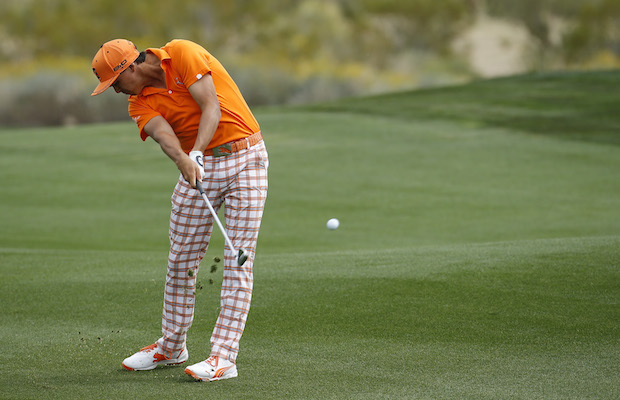
There’s no one perfect way to swing a golf club, but there are specific positions that have proven to be consistently successful.
In this article, I would like to show you five, time-tested positions that we can all strive to achieve. You don’t have to match these positions perfectly, but the closer you get to them the better your swing will be fundamentally.
Remember, don’t perform major surgery when an aspirin will do. These are suggestions for improvement, not a guide to completely overhaul your swing.
No. 1: The Bump
- Everyone strives to begin the downswing from the ground up and here is a great example of the hips doing all the work.
- The weight is on the inside of the rear foot at the top, thus allowing the hips to “push off” something during the transition. Too many golfers allow their weight to move to the outside of the rear foot at or near the top of the backswing.
- The shoulders have turned enough to allow the hands to move around the body, not just lift to the top, to load up the weight on the rear foot.
- From the top, the weight bumps forward in the direction of the hips. For most people, moving the weight into the left toe from the top is enough to make things work correctly.
- When the hips spin, the weight moves into the left heel and the right shoulder is thrown out and over.
No. 2: Back and Down
- I’m often asked what the right shoulder does during the downswing, and here is a great photo of how it stays back and down from the top into the transition.
- The arms have worked across the body so that the left arm is somewhere around the right shoulder, which is not for everyone, but it seems to work for this player. I suggest having the left arm between the shoulder and the right ear for most players.
- As the hips bump, the rear shoulder stays back, or at least it does not rotate forward just yet. This causes the arms to work more downward, not outward, for a split second. That moves the club into an inside delivery position.
- When the right shoulder dives forward and toward the ball in a wood-chopping motion from the top, the path is shifted left and you will tend to hit down too steeply into the ball.
- Looking at her legs in the right frame also shows us that she has not spun out from the top while her shoulder moves downward.
- You can feel the hips bump rightward to drop the rear shoulder, or you can drop the right shoulder to move the hips laterally. It’s all about your feel of what happens, but biomechanically the hips lead the pivot during the transition.
No. 3: Right Forearm Inline
- If there was one secret of consistent ball striking that I feel we could ALL get better at, it would be working into impact with our rear forearm and club shaft inline.
- Having the rear arm and club shaft inline provides maximum support with positive alignments that allow the club shaft to return very closely to its address position. The closer you can get to that position, the better it is for you in theory. My thought is to try your best not to change it too much up or down from its position at impact for the best results.
- The best ball strikers in the game have the right forearm and shaft inline at impact. Check out Trevino, Price and Hogan if you don’t believe me!
- The key to achieving this position is to have the proper transitional motion from the top, coupled with a solid pivot of the upper body through the ball. It’s not the easiest position to achieve, but the payoff is worth the hard work.
No. 4: Left Arm and Club Shaft Inline
- Impact in a perfect world would be an in-line condition as shown above. Whenever the shaft lags behind the hands at impact, or vice versa, it’s hard to coordinate the closing rate of the clubface, as well as the club’s dynamic loft. This leads to off-line shots and inconsistent trajectory.
- This is the impact position of a very high ball hitter. His head is behind the ball and the club is being returned to the ball with a ton of speed. This player is using the exact static loft designed into the club (within reason).
- This type of impact condition produces the correct amount of spin as determined by the difference between the angle of attack and the dynamic loft of the club. That’s known as spin loft.
- In order to achieve this position, golfers must have the lower body working into a posted position so the right shoulder can “cover the ball” a touch more. When the right shoulder lags too far down and behind, the hands will tend to flip.
- Too much lateral head slide will move the lowpoint forward, and you will tend to reduce the dynamic loft of the club too much. This results in shots that come off too low.
No. 5: The Proper Low Point
- The very best fundamentals in the world cannot overcome a faulty lowpoint. If you cannot hit the ball solid, you will never play your best.
- I have charted the low point in the left frame, showing you that this player hit the ground AFTER the ball has left the blade, NOT before.
- As you’ve probably heard before, you must hit the little ball (golf ball) before the big ball (the earth).
- The key to controlling your lowpoint is to have a proper pivot motion, which is how you twist and turn during the swing. Weight displacement will also affect your lowpoint.
- If you have trouble with your low point, draw a line in the grass and try to make divots after the line on the targetside. To do this you MUST move your weight forward to some degree.
- Lowpoint control is very difficult on the flattest of lies, but to reach your full potential as a golfer you must practice lowpoint control on the most hilly of lies.
Again, these positions are general ideas of what I like to see my students achieve during the swing. There is NO one way to swing a golf club that works for everyone, but these fundamentals are generally helpful. Experiment with your swing and see where you compare to these great professionals and hopefully you’ll gain the insight you need to get better!
- LIKE7
- LEGIT1
- WOW0
- LOL0
- IDHT0
- FLOP0
- OB0
- SHANK0
Instruction
Clement: Laid-off or perfect fade? Across-the-line or perfect draw?

Some call the image on the left laid off, but if you are hitting a fade, this could be a perfect backswing for it! Same for across the line for a draw! Stop racking your brain with perceived mistakes and simply match backswing to shot shape!
- LIKE0
- LEGIT0
- WOW0
- LOL0
- IDHT0
- FLOP0
- OB0
- SHANK1
Instruction
The Wedge Guy: The easiest-to-learn golf basic

My golf learning began with this simple fact – if you don’t have a fundamentally sound hold on the golf club, it is practically impossible for your body to execute a fundamentally sound golf swing. I’m still a big believer that the golf swing is much easier to execute if you begin with the proper hold on the club.
As you might imagine, I come into contact with hundreds of golfers of all skill levels. And it is very rare to see a good player with a bad hold on the golf club. There are some exceptions, for sure, but they are very few and very far between, and they typically have beat so many balls with their poor grip that they’ve found a way to work around it.
The reality of biophysics is that the body moves only in certain ways – and the particulars of the way you hold the golf club can totally prevent a sound swing motion that allows the club to release properly through the impact zone. The wonderful thing is that anyone can learn how to put a fundamentally sound hold on the golf club, and you can practice it anywhere your hands are not otherwise engaged, like watching TV or just sitting and relaxing.
Whether you prefer an overlap, interlock or full-finger (not baseball!) grip on the club, the same fundamentals apply. Here are the major grip faults I see most often, in the order of the frequency:
Mis-aligned hands
By this I mean that the palms of the two hands are not parallel to each other. Too many golfers have a weak left hand and strong right, or vice versa. The easiest way to learn how to hold the club with your palms aligned properly is to grip a plain wooden ruler or yardstick. It forces the hands to align properly and shows you how that feels. If you grip and re-grip a yardstick several times, then grip a club, you’ll see that the learning curve is almost immediate.
The position of the grip in the upper/left hand
I also observe many golfers who have the butt of the grip too far into the heel pad of the upper hand (the left hand for right-handed players). It’s amazing how much easier it is to release the club through the ball if even 1/4-1/2″ of the butt is beyond the left heel pad. Try this yourself to see what I mean. Swing the club freely with just your left hand and notice the difference in its release from when you hold it at the end of the grip, versus gripping down even a half inch.
To help you really understand how this works, go to the range and hit shots with your five-iron gripped down a full inch to make the club the same length as your seven-iron. You will probably see an amazing shot shape difference, and likely not see as much distance loss as you would expect.
Too much lower (right) hand on the club
It seems like almost all golfers of 8-10 handicap or higher have the club too far into the palm of the lower hand, because that feels “good” if you are trying to control the path of the clubhead to the ball. But the golf swing is not an effort to hit at the ball – it is a swing of the club. The proper hold on the club has the grip underneath the pad at the base of the fingers. This will likely feel “weak” to you — like you cannot control the club like that. EXACTLY. You should not be trying to control the club with your lower/master hand.
Gripping too tightly
Nearly all golfers hold the club too tightly, which tenses up the forearms and prevents a proper release of the club through impact. In order for the club to move back and through properly, you must feel that the club is controlled by the last three fingers of the upper hand, and the middle two fingers of the lower hand. If you engage your thumbs and forefingers in “holding” the club, the result will almost always be a grip that is too tight. Try this for yourself. Hold the club in your upper hand only, and squeeze firmly with just the last three fingers, with the forefinger and thumb off the club entirely. You have good control, but your forearms are not tense. Then begin to squeeze down with your thumb and forefinger and observe the tensing of the entire forearm. This is the way we are made, so the key to preventing tenseness in the arms is to hold the club very lightly with the “pinchers” — the thumbs and forefingers.
So, those are what I believe are the four fundamentals of a good grip. Anyone can learn them in their home or office very quickly. There is no easier way to improve your ball striking consistency and add distance than giving more attention to the way you hold the golf club.
More from the Wedge Guy
- The Wedge Guy: Golf mastery begins with your wedge game
- The Wedge Guy: Why golf is 20 times harder than brain surgery
- The Wedge Guy: Musings on the golf ball rollback
- LIKE86
- LEGIT13
- WOW6
- LOL1
- IDHT0
- FLOP4
- OB1
- SHANK8
Instruction
Clement: Stop ripping off your swing with this drill!

Not the dreaded headcover under the armpit drill! As if your body is defective and can’t function by itself! Have you seen how incredible the human machine is with all the incredible feats of agility all kinds of athletes are accomplishing? You think your body is so defective (the good Lord is laughing his head off at you) that it needs a headcover tucked under the armpit so you can swing like T-Rex?
- LIKE0
- LEGIT2
- WOW2
- LOL0
- IDHT0
- FLOP0
- OB0
- SHANK2
-

 19th Hole2 weeks ago
19th Hole2 weeks agoDave Portnoy places monstrous outright bet for the 2024 Masters
-

 19th Hole3 days ago
19th Hole3 days agoJustin Thomas on the equipment choice of Scottie Scheffler that he thinks is ‘weird’
-

 19th Hole2 weeks ago
19th Hole2 weeks agoTiger Woods arrives at 2024 Masters equipped with a putter that may surprise you
-

 19th Hole3 days ago
19th Hole3 days ago‘Absolutely crazy’ – Major champ lays into Patrick Cantlay over his decision on final hole of RBC Heritage
-

 19th Hole2 weeks ago
19th Hole2 weeks agoTwo star names reportedly blanked Jon Rahm all week at the Masters
-

 19th Hole1 week ago
19th Hole1 week agoReport: LIV Golf identifies latest star name they hope to sign to breakaway tour
-

 19th Hole1 week ago
19th Hole1 week agoNeal Shipley presser ends in awkward fashion after reporter claims Tiger handed him note on 8th fairway
-

 19th Hole1 week ago
19th Hole1 week agoBrandel Chamblee has ‘no doubt’ who started the McIlroy/LIV rumor and why

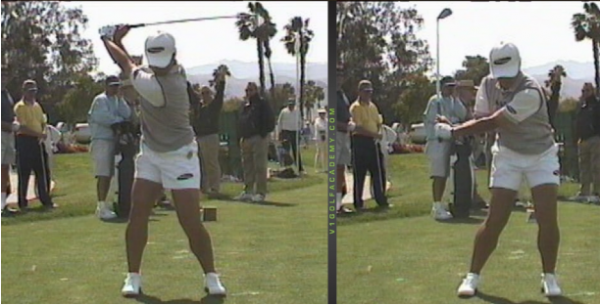
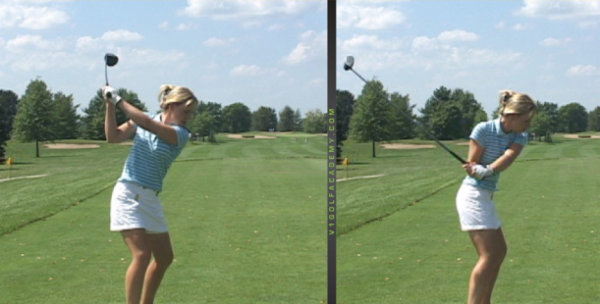
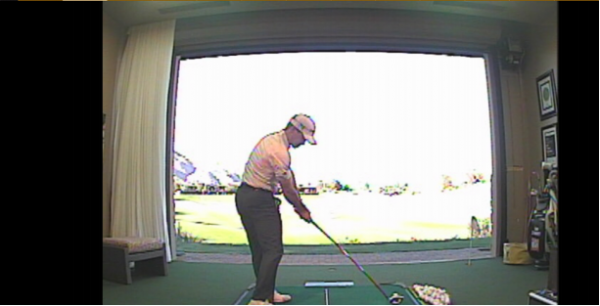
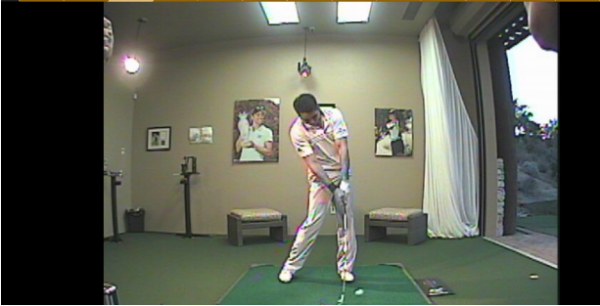
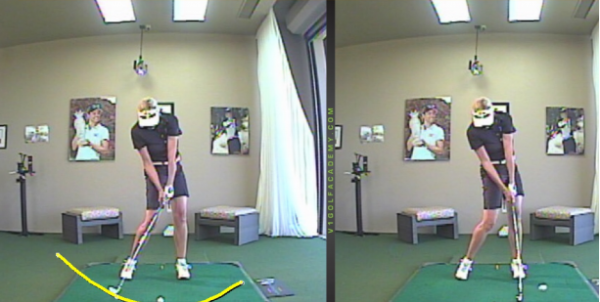















ballhog
Oct 13, 2014 at 2:45 pm
By the shaft being in-line with the right forearm, do you mean from a side view (as shown in the picture above)?
mat69
Aug 5, 2014 at 4:27 am
good article,
im working left hip over tee peg past my hip in ground on downswing
on posting up on left leg, and working on impact left palm matching clubface pointing up after impact.
tom stickney
Aug 5, 2014 at 10:49 am
Great…sounds like you are on the correct track
Tahoedirt
Aug 6, 2014 at 8:01 pm
I guess I’m constantly “picking” the ball- As in the incorrect position in No 5. I never take a divot and don’t hit ball very far, but I do hit it very high- Please help with drills etc and thank you. This is one of the best articles I’ve ever read about striking the golf ball.
Tom Stickney
Aug 7, 2014 at 10:17 am
Thank you…use this drill from my youtube channel.
http://youtu.be/QelA-1mnA9I
Andrew
Aug 4, 2014 at 9:03 pm
I like #1’s hip bump to the left heel. I have been landing on my left heel spinning out.
tom stickney
Aug 5, 2014 at 10:49 am
Very common problem sir
Andrew
Aug 4, 2014 at 9:03 pm
I like #’s hip bump to the right foot. I think I have been landing on my left heel and spinning out.
snowman
Aug 4, 2014 at 5:24 pm
Where can I see the photos that are mentioned?
snowman
Aug 4, 2014 at 5:25 pm
Now I see them. Sorry. Slow hotel internet I guess…..
Tom Stickney
Aug 4, 2014 at 5:52 pm
Thx
Alex
Aug 4, 2014 at 1:37 pm
#2 is an interesting tip and is likely one of the reasons for my large divots. Question on your wording:
“You can feel the hips bump rightward to drop the rear shoulder, or you can drop the right shoulder to move the hips laterally.”
Should this have said bump left, assuming a RH swing?
Tom Stickney
Aug 4, 2014 at 3:00 pm
No. Hips bump into rt field
Knobbywood
Aug 4, 2014 at 11:15 pm
What? Please explain… Hips bump into right field to start your downswing?
tom stickney
Aug 5, 2014 at 10:51 am
Your hips are pointed into right field at the top of your backswing; thus, they need to bump in that direction (slightly) to allow the rear shoulder to drop moving the club to the inside. What too many golfers do is spin the hips from the top throwing the rt shoulder out and over the top.
Take the rt field bump in moderation…
Knobbywood
Aug 5, 2014 at 11:05 am
Oooooooooh! I see what you are saying… If you are standing at homeplate you hips move towards right field… My comments were based on my interpretation of your instructions… I thought you meant slide right as in directly away from the target… Hence my confusion… Thx for the update
Knobbywood
Aug 5, 2014 at 9:01 am
Hips bump RIGHT for a right handed golfer? Try that move right now to start your transition… Weight moves to your back foot and you come right over the top
tom stickney
Aug 5, 2014 at 10:52 am
Not sure what you mean…if your weight slides forward how can you be on your back foot?
Tom Stickney
Aug 5, 2014 at 1:45 pm
My pleasure to clarify things.